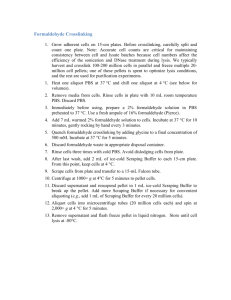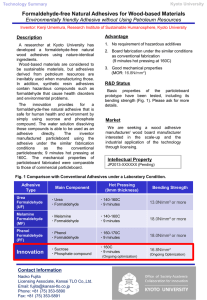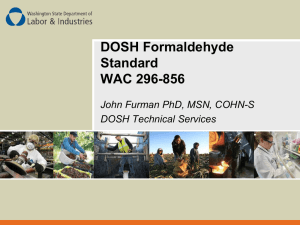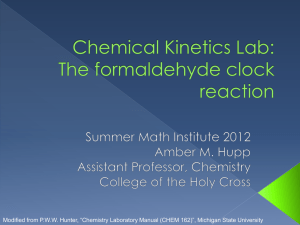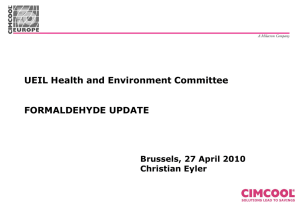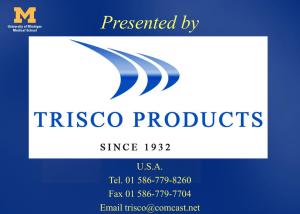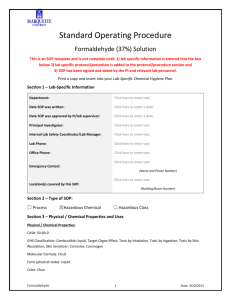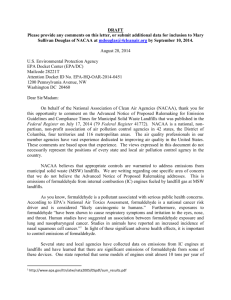UA-Formaldehyde-Plan - Environmental Health & Safety
advertisement
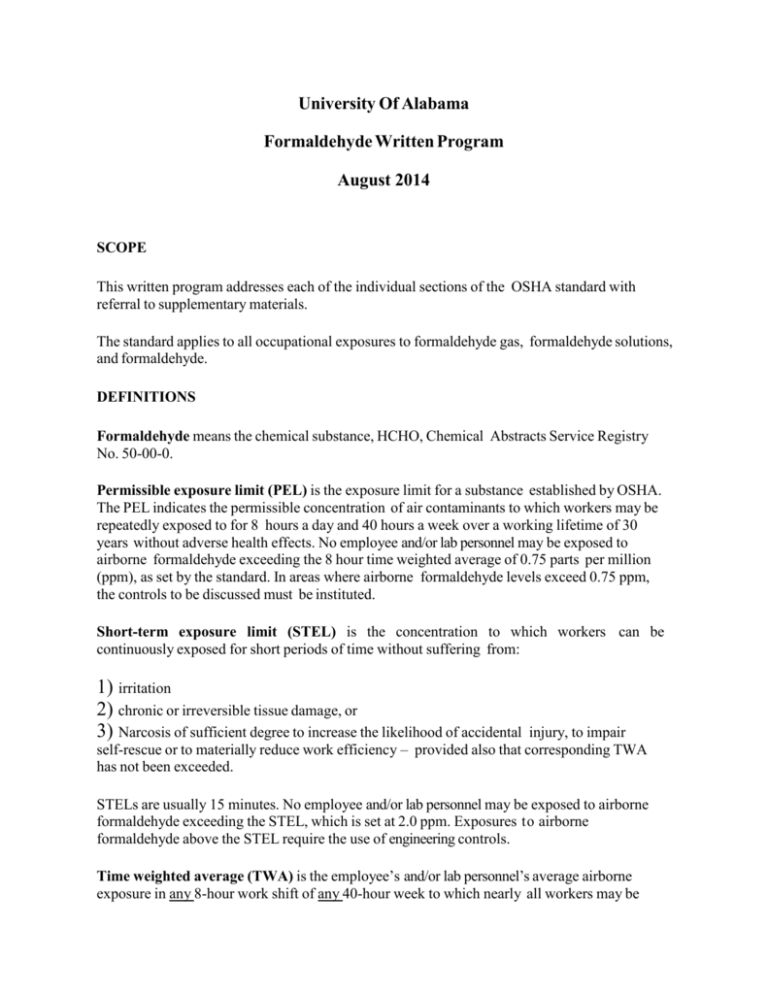
University Of Alabama Formaldehyde Written Program August 2014 SCOPE This written program addresses each of the individual sections of the OSHA standard with referral to supplementary materials. The standard applies to all occupational exposures to formaldehyde gas, formaldehyde solutions, and formaldehyde. DEFINITIONS Formaldehyde means the chemical substance, HCHO, Chemical Abstracts Service Registry No. 50-00-0. Permissible exposure limit (PEL) is the exposure limit for a substance established by OSHA. The PEL indicates the permissible concentration of air contaminants to which workers may be repeatedly exposed to for 8 hours a day and 40 hours a week over a working lifetime of 30 years without adverse health effects. No employee and/or lab personnel may be exposed to airborne formaldehyde exceeding the 8 hour time weighted average of 0.75 parts per million (ppm), as set by the standard. In areas where airborne formaldehyde levels exceed 0.75 ppm, the controls to be discussed must be instituted. Short-term exposure limit (STEL) is the concentration to which workers can be continuously exposed for short periods of time without suffering from: 1) irritation 2) chronic or irreversible tissue damage, or 3) Narcosis of sufficient degree to increase the likelihood of accidental injury, to impair self-rescue or to materially reduce work efficiency – provided also that corresponding TWA has not been exceeded. STELs are usually 15 minutes. No employee and/or lab personnel may be exposed to airborne formaldehyde exceeding the STEL, which is set at 2.0 ppm. Exposures to airborne formaldehyde above the STEL require the use of engineering controls. Time weighted average (TWA) is the employee’s and/or lab personnel’s average airborne exposure in any 8-hour work shift of any 40-hour week to which nearly all workers may be repeatedly exposed, day after day, without suffering any adverse effects. It is a value that shall not be exceeded. Formaldehyde’s TWA is >0.75 ppm. Action Level (AL) is an 8-hour time weighted average concentration for which there is only a 5% risk of having more than 5% of the employee workdays involve an exposure level greater than the relevant PEL-TWA. This value is more frequently set at or near 50% of the PEL-TWA. The action level for formaldehyde means a concentration of 0.5 part formaldehyde per million parts of air (0.5 ppm) calculated as an 8-hour time weighted average concentration. Employee exposure means the exposure to airborne formaldehyde which would occur without corrections for protection provided by any respirator that is in use. EXPOSURE MONITORING EHS shall monitor employees and/or lab personnel for formaldehyde exposure when exposure is to formaldehyde gas, mixtures or solutions with more than 0.1% formaldehyde or materials capable of releasing formaldehyde into the air under normal conditions where the concentration is equal to or exceeds 0.1 ppm. Health complaints possibly associated with formaldehyde exposure also trigger a requirement to monitor. If objective data can document that the presence of formaldehyde cannot cause exposure above the action level or STEL, exposure monitoring is not required. When exposures exceed the action level, monitoring is to be conducted at least every six months. When the STEL is exceeded, monitoring is repeated at least once a year under worst conditions. Monitoring can be terminated when two consecutive and statistically representative samples, at least seven days apart, show exposure to be below the action level and the STEL. Employees and/or lab personnel must be notified of results in writing within 15 days of EHS receiving results. When exposure is over the 8- hour TWA or the STEL, EHS shall develop a plan of corrective action. Employees and/or lab personnel have a right to observe monitoring and to have appropriate protective gear made available by the University while doing so. RESTRICTED AREAS When formaldehyde exposure exceeds the 8-hour TWA or STEL, the area is to be designated as a restricted area. Entrances and access ways must be posted (See appendix A) and access restricted to authorized personnel with appropriate training. These restrictions must be communicated to lab personnel and/or personnel of other groups or employers, such as construction contractors, with operations at the worksite in question. METHODS OF COMPLIANCE Engineering controls and work practices: The P.I./Lab Supervisor shall utilize engineering and work practice controls to reduce and maintain employee exposures to formaldehyde at or below the TWA and the STEL. Whenever the these two combined options cannot reduce employee exposure to or below either of the PELs, the P.I./Lab Supervisor shall provide respirators to satisfy the standard. These methods must be used when either the 8-hour TWA or STEL is exceeded. These methods include, in order of descending primacy, engineering controls, work practice controls, respirators and other personal protective equipment. When engineering and work practice controls cannot reduce exposure below either of the PELs, appropriate respirators may be used as a supplement. Employees and/or lab personnel should work with formaldehyde only in an approved chemical fume hood. Supervisors should exhaust all engineering controls and work practice controls prior to implementation of respiratory protection. RESPIRATORY PROTECTION When required, respirators must be supplied at no cost to lab personnel. EHS must be consulted when respirator usage is considered. The UA Respiratory Protection Program (http://ehs.ua.edu/operations/occupational-safety/respiratory-protection/) requirements must be met prior to respirator use. At that time, training, fit testing, and cartridge/canister selection and replacement will be discussed. PERSONAL PROTECTIVE EQUIPMENT AND CLOTHING Personal protective equipment (PPE) also must be provided at no cost to the employee and/or lab personnel. Any contact of eyes and skin with liquids containing 1% or more of formaldehyde must be prevented by the use of PPE and clothing. Only formaldehyde impervious clothing (i.e. tyvek, coveralls), goggles and face shields appropriate to the operation must be used. Contact EHS for help in proper selection, usage, and equipment maintenance. HYGIENE PROTECTION Changing facilities, eye washes and drench showers are required under this section. Immediate access to such equipment must be provided. Most laboratories have eyewashes and showers. However, if a laboratory does not have an eyewash and shower, please contact EHS personnel for evaluation and assistance. HOUSEKEEPING Regular visual inspection for leaks and spills should be conducted. Provisions must be made for spill containment, work area decontamination and waste disposal. Sealed containers holding debris from spills must be labeled to indicate the presence and associated hazards of formaldehyde. EMERGENCIES EHS can assist with emergency response for various types of accidents. The SDS also contains relevant information. [Chemical Hygiene Plan] MEDICAL SURVEILLANCE The University shall institute medical surveillance programs for all employees and/or lab personnel who are exposed to formaldehyde at concentrations at or exceeding the action level or the STEL and for any employees and/or lab personnel who develop signs and symptoms of over exposure to formaldehyde and to all employees exposed to formaldehyde in emergencies. When determining whether an employee may be experiencing signs and symptoms of possible overexposure to formaldehyde, the employer may rely on the evidence that signs and symptoms associated with formaldehyde exposure will occur only in exceptional circumstances when airborne exposure is less than 0.1 ppm and when formaldehyde is present in material in concentrations less than 0.1 percent. All medical procedures shall be performed by a licensed physician and according to details outlined in the standard. HAZARD COMMUNICATION All sections of the formaldehyde SDS must be reviewed by the laboratory/area supervisor in detail with all formaldehyde users. The SDS will contain the following information specific to formaldehyde: ◦ material identification ◦ ◦ ◦ ◦ ◦ ◦ ◦ toxicity hazards* health hazards* physical data* fire and explosion hazards reactivity spill or leak procedures handling and storage precautions *Emphasize these sections, especially formaldehyde’s potential carcinogenicity. Formaldehyde containers must be labeled to identify formaldehyde and its hazards. SDSs must be kept up-to-date. The occupational health hazards of formaldehyde are primarily due to its toxic and irritant effects after the inhalation, direct contact with the skin or eyes or after ingestion. Acute effects of exposure by ingestion would produce severe irritation, chemical burns, and inflammation of the mouth, throat, and stomach. Inhalation of formaldehyde would lead to irritation of the upper respiratory tract and eyes, drowsiness, dizziness, loss of reflexes, and vertigo. Concentrations above 20 ppm would lead to heavy tearing, difficult breathing, cough, and burning of the nose and throat and could lead to severe respiratory injury. Dermal contact causes chemical burns, discoloration, burning, drying, and possible cracking and scaling of the skin. Previously exposed persons may react to future exposure with an allergic eczematous dermatitis or hives. Eye contact by splashing can result in severe permanent corneal clouding and possibly loss of vision. Transient irritation may result from high ambient air levels. TRAINING The P.I./Lab supervisor shall assure that all employees, lab personnel, and/or students who are assigned to workplaces where exposure to formaldehyde participate in a training program unless this exposure will be less than 0.1 ppm. Training must describe specific operations in the work area where formaldehyde is present and must explain safe work practices appropriate for limiting formaldehyde exposure in each procedure. Formaldehyde users shall be provided training at the time of initial assignments, and whenever exposure to formaldehyde is introduced. Training will include a description of the potential health hazards and signs and symptoms associated with exposure. Training shall be repeated at least annually. It is the responsibility of the lab/area supervisor to insure all applicable employees, lab personnel and/or students receive training. Workers shall be shown specific operations in the workplace involving formaldehyde by their supervisors and shall be provided SDS information for review. RECORD KEEPING Records must be kept for exposure measurements; medical surveillance and respirator fit testing (contact EHS for specific information to be gathered and maintained per standard). Exposure records must be kept for 30 years, medical records for the duration of employment plus 30 years, and respirator fit testing records for the period until a more recent record is generated. These records must be made available to affected employees and/or lab personnel upon request. Appendix A:
